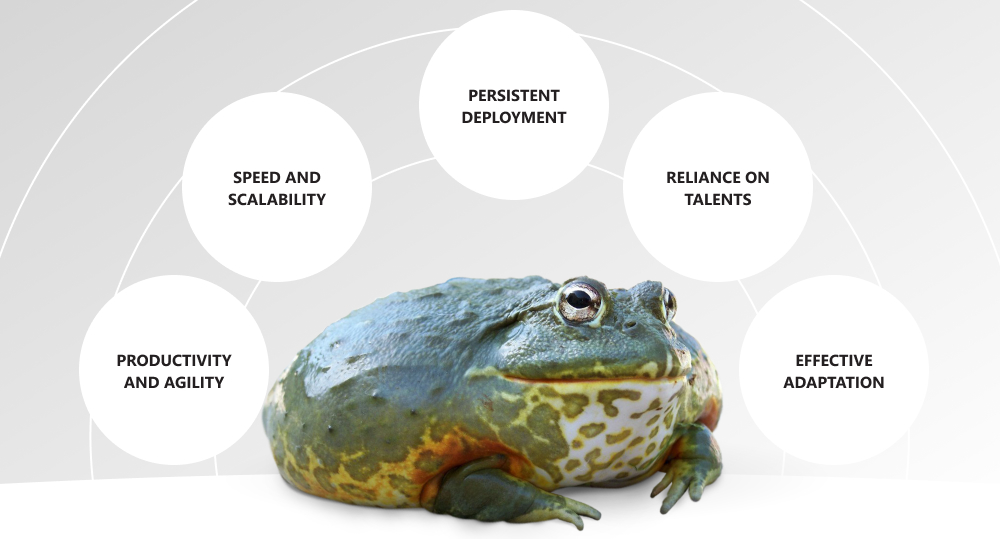How much time do we spend with mobile apps? The latest report by App Annie revealed stunning results: mobile users spent 3.8 trillion hours using apps in 2021. Can you imagine? No surprise that edgy technologies, such as microservices in mobile app development, are the modern trend in apps for banking, shopping, fitness, games, and what not!
Our new article is a careful outlook on the benefits of microservices and some great examples of mobile apps with this type of architecture.
written by:
Dmitry Tychko
Senior Software Developer
Contents
What Are App Microservices?
First, let us try to turn to the essentials and understand what exactly microservices are for mobile apps.
Well, microservices architecture means fragmentation of a large application into a set of coupled smaller services, and each of them is focused on separate business functionality.
Microservices can be deployed and tested flawlessly or redeployed, if necessary. And you will not have to compromise the application integrity as microservices architecture leads to the facilitation of effective deployment in a flash.
Microservices Are Transforming App Development Strategies
Does that mean that this architecture is a big draw today? Not that simple.
According to Statista, in 2021, only 34% of respondents stated that they used microservices. About 37% answered that they used the architecture partially. And 28% of enterprises did not implement microservices architecture for application delivery.
What are the main differences between the innovative microservices approach and traditional monolithic architecture? To understand that we will try to sketch out the distinctive features of both architectures.
Monolithic Architecture
The core process of this conventional approach to mobile app development is to connect all parts of your application reciprocally. Each of the components is an interdependent part. So, if there is some fault in one component, all the others won't function properly. And the end product respectively.
What does an app with monolithic architecture look like?
For a mobile app, it implies a strong interconnection between the functional parts of your application. As a rule, a monolith app is placed in a single repository and all your development teams work in one common repository.
Thus, when you make changes into any component of your application the likelihood of mistake grows significantly due to the closely-coupled functional structure.
Furthermore, it becomes even more complicated when your application is built by several teams. Error isolation becomes much more difficult. And also you can’t rely on fast releases as all the teams have to sync the preparedness level of their features.
One more thing is that it takes you much more time and resources to assemble a large mobile app with monolithic architecture than to put together microservices.
That doesn't sound like fun, huh?
Microservices Architecture
Meanwhile, the process of mobile app development in microservices architecture is completely different. Here, you create discrete parts of your application. Every component is deployed individually and has its functionality.
How do they manage to work together flawlessly? Different components are connected by lightweight APIs.
When the components do not depend on each other, you can easily make necessary alterations. You will not have to change the whole system every time.
Which Apps Use Microservices?
We have handpicked three vivid examples of large applications that have already implemented microservices architecture. Let us see how it helped them to meet the new market requirements and step closer to their users.
Amazon
When the company started its prolific journey in the early 2000s, it was a bulky desktop monolithic application for retail. It means that in those times, Amazon developers had to thoroughly untangle dependencies for every upgrade or scaling.
No wonder, that very soon Amazon started breaking its monolithic app into service-specific, independently-running applications. Its developers pulled out units of code from the source code according to their functional purpose and wrapped them into a service interface. For example, there is a separate service for tax calculators, the Buy button, etc. All of them communicate via their APIs.
The company was one of the pioneers of microservices architecture. Thank you, Amazon!
Netflix
This loud name in the modern entertainment industry started its business in 2007. And just a year later, Netflix was completely stacked against service failures and scalability demands.
Are you surprised that for the streaming giant it was a life-and-death issue to find an innovative solution for its business?
So, Netflix started decoupling its monolithic architecture into microservices. That helped the company to overcome its service outages and scaling challenges.
Uber
Did Uber also suffer from its initial monolithic application structure? It struggled with development and deployment issues, bug fixing, and integration problems. The fast-growing global business urgently needed an innovative solution instead of the inefficient one.
The remedy was found in cloud-based microservices architecture. All Uber functions now work independently — trip management, passenger management, and more. All its microservices are connected via an API Gateway.
Why Does Your Mobile App Need Microservices?
Let us focus on the practical benefits of microservices architecture. Here are five considerable advantages that microservices will provide for your mobile app.
Be More Productive and Agile
When you apply your development teams for building, deploying, and testing individual components your specialists get more breathing space. They can use the best suitable language and framework for every functionality they work on.
As we have already mentioned, the microservices approach is much faster as you don't have to change the entire application every time you implement new components. What is more, you will discard the volume of code to be written.
Improve Speed and Scalability
With microservices architecture, you will meet your customers' needs in a zip. It comes as no surprise that you have to be yarely adaptable in our highly-competitive mobile app market. Your customers are unlikely to stay loyal if they will have to wait long maintenance breaks regularly.
At the same time, microservices components are changed, fixed, and scaled individually. They can be altered on demand and your app can be highly responsive to the latest market requirements.
Provide Persistent Deployment
One more essential advantage of microservices architecture is the constant deployment model of your cross-functional teams. Your specialists will be able to build dedicated teams within a continuous mobile app development lifecycle as development, testing, individual services, and debugging occur in continuous iterations. And do not forget about the strategic relevant feedback of your development team members.
Make the Most of Your Talents
On the other hand, smaller services require more compact teams. That, in its turn, provides greater freedom to your specialists. They can take up faster decisions which will make the mobile app development process quick and more productive.
Adapt in the Best Way
Microservices architecture helps to deliver the best services to your customers. If there are any troubles with a faulty function you can switch to another one and your app will be functioning. And your team can focus on fixing the component.
Another amazing example of microservices adaptability is its preparedness for quick controlled changes. For instance, when you want to adapt your mobile app to the new gadget types or edgy tech stack.
A Brief Guide on Implementing Microservices on Android and iOS
So, how to implement microservices architecture on your Android or iOS app. Here is our vision of what steps you should take.
- Decide on whether your mobile app project needs this architecture.
- Analyze the infrastructure you already have and prepare your team.
- If you are moving your mobile app from monolithic to microservices, coordinate with your data admin to keep them fully informed.
- Choose the best suitable programming languages and frameworks.
- Build the base architecture (services, containers).
- If you decouple a monolithic architecture and it has a database, divide your database into smaller parts.
- Perform automated testing as early as possible.
Not that complicated, right?
Some Rain at the Microservices Parade
To be honest, there are also some drawbacks in microservices architecture. They lay in the perspective of separate functions as its most essential feature.
Thus, the tech stack of your mobile app can include multiple languages, libraries, and frameworks. You have to be prepared to toss all these with high proficiency. And of course do not forget about overhead costs for microservices architecture maintenance — you will have to build and implement the architecture, test and update it.
That is why it is of prime importance to choose a reliable partner with production-proven solutions who has the experience, technical assets, and excellent expertise.
Wrapping It Up
We are sure that microservices architecture is highly efficient for your large mobile app. You will benefit with agile, robust, and reliable development and delivery of your project. With microservices, your app will be more productive, innovative, adaptable, and easily scalable.
While the business advantages of shifting to microservices architecture are tremendous, you need to carefully monitor and strategically implement the transformation.
Why not contact our specialists and get our expert advice on microservices for your mobile app? We, at Qulix Systems, are ready to make you the best offer on mobile application development.

Contacts
Feel free to get in touch with us! Use this contact form for an ASAP response.
Call us at +44 151 528 8015
E-mail us at request@qulix.com












